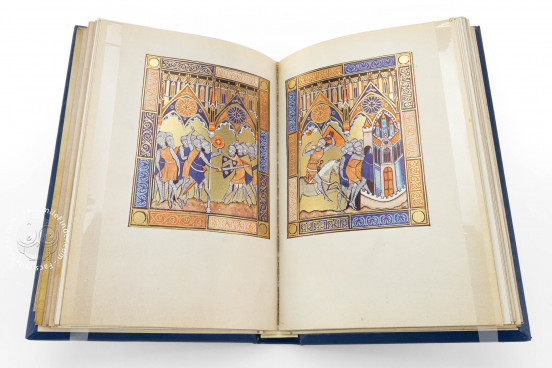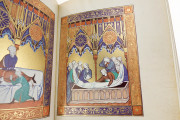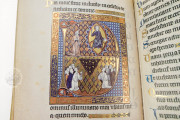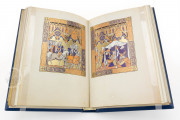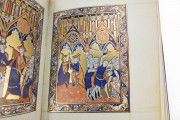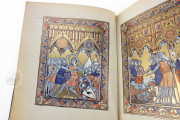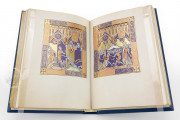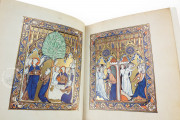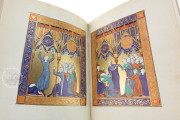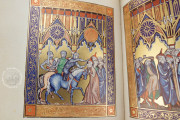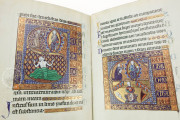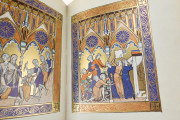A royal commission of outstanding beauty and expense, the Saint Louis Psalter is one of the greatest achievements of Gothic illumination. This deluxe private prayerbook was most likely commissioned of a Parisian workshop by Louis IX, the Capetian king of France famous for his exemplary religiosity, for his zealous Crusading, and for his energetic patronage of innovative works of Gothic art and architecture. Well known for its prefatory cycle of Old Testament narrative scenes enclosed in architectural settings mimicking a Rayonnant Gothic church exterior, biblical characters depicted as Capetian kings or French Crusaders, and backgrounds patterned with the coats of arms of Louis IX and his allies, this book unites sacred Biblical history with the mythology of a Crusader saint-king.
Following its preface, the Psalter of Saint Louis contains a liturgical calendar made for use at the Sainte-Chapelle, the text of the Psalms, and canticles from the Old and New Testaments. It is probable that one or two gatherings are missing from the end and that the Psalter would have originally included litanies of saints and other services, making it a comprehensive devotional tool.
A Jewel of Rayonnant Gothic Illumination
The main decorative program of the Psalter of Saint Louis is its prefatory cycle composed of seventy-eight full-page illustrations of the Old Testament. These illuminations are arranged in diptychs of facing recto and verso; on the reverse of each illustration is a brief explicative legend on Old French.
One of the four or five artists who participated in the decoration of the preface also decorated the Psalter and Hours of Isabelle of France, made for the sister of Louis IX for use at the Sainte-Chapelle (Cambridge, Fitzwilliam Museum, MS 300). Also notable are the eight large historiated initials that mark the liturgical division of the Psalms.
The style of the illuminations is one of the finest examples of Rayonnant Gothic, with highly burnished gold grounds, a restricted yet luminous palette centered on blue and pink, graceful S-shaped figures with curly hair and benign facial expressions, and a fluid rhythm to the overall page.
The Liturgical Day at a Glance
The text is written in an elegant Gothic bookhand, with well-proportioned letters executed in regular strokes and with few abbreviations, probably by two scribes. Other than the eight Psalms that begin with the historiated initials, every Psalm and canticle opens with an initial of burnished gold against pink and blue grounds decorated with fine gold rinceaux.
In turn, each verse begins with alternating gold and blue initials. Line-enders made up of bands of rinceaux alternating with coats of arms in blue, pink, and gold balance the pages and help guide the reader’s eye to the relevant passages.
A Relic of Kingdom Past
A treasured relic associated with Louis IX, who was canonized in 1297, the Psalter initially remained in the hands of the monarchy. Its esteemed owners included Jeanne d’Evreux, Charles V, and Charles VI.
Sometime after 1397 the manuscript followed Marie de France to her convent at Poissy and reappeared in the Moscow collection of the Russian count Alexis Golovkin in 1798. By 1811 the Psalter had passed to the collection of Prince Mikhail Petrovich Golitzin, an equerry to Tsar Alexander I.
In 1818 the French ambassador to Saint-Petersburg, the count of Noailles, acquired the manuscript from prince Golitzin and, just a few days before the feast of Saint Louis, ceremoniously presented it to Louis XVIII. Soon afterwards the Psalter was deposited to its definitive home at the Bibliothèque nationale.
We have 1 facsimile edition of the manuscript "Saint Louis Psalter": Psautier de Saint Louis facsimile edition, published by Akademische Druck- u. Verlagsanstalt (ADEVA), 1972
Request Info / Price
